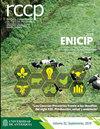Effect of the percentage of Bos taurus inheritance on the fertility of Holstein×Zebu and Brown Swiss×Zebu crossbred cows in the Mexican tropics
IF 0.5
4区 农林科学
Q4 AGRICULTURE, DAIRY & ANIMAL SCIENCE
引用次数: 2
Abstract
Effect of the percentage of Bos taurus inheritance on the 41 fertility of Holstein x Zebu and Brown Swiss x Zebu crossbred cows in the Mexican tropics. Rev Colomb Abstract reproduction. Objective: To assess the effect of the proportion of Bos taurus (Bt) genes 51 on the reproductive performance of Holstein × Zebu (HZ) and Brown Swiss × Zebu (BZ) 52 crossbred cows, and to compare the reproductive performance of these genotypes in a 53 dual-purpose production system. Methods: Cows were maintained in a rotational grazing 54 system on African Star grass ( Cynodon plectostachyus ) in Veracruz, Mexico. Cows were 55 milked twice daily. Calves were kept tied on one side of their dams, while the cows were 56 milked. Results: Percentage of Bt genes did not affect (p>0.05) any fertility trait (age at 57 first calving, days to first service after calving, services per conception, first service 58 conception rate, days open until conception, gestation length and calving interval) of BZ 59 cows. In contrast, HZ cows with less than 75% of Holstein (H) genes were 0.3 years 60 younger (p<0.05) at first calving and had 39.8 fewer days open (p<0.05) than HZ cows 61 with 75% or more of H genes. In addition, the calving interval of HZ cows with less than 62 75% of H genes was 44.8 days shorter (p<0.05) than that of HZ cows with 75% or more 63 of H genes. HZ cows had five fewer days pregnant and were 22.8 kg heavier at calving 64 (p<0.05) than BZ cows. Conclusions: The effect of the percentage of Bt genes on cow 65 fertility depended on the dairy breed used. In general, BZ and HZ cows had similar 66 reproductive performance.墨西哥热带地区牛头牛遗传率对荷斯坦×泽布和棕色瑞士×泽布杂交奶牛生育能力的影响
墨西哥热带地区荷斯坦×泽布和褐瑞×泽布杂交母牛遗传率对41育性的影响。Rev Colomb抽象复制。目的:研究牛牛Bt基因51的比例对荷斯坦× Zebu (HZ)和布朗瑞士× Zebu (BZ) 52杂交奶牛繁殖性能的影响,并比较这两种基因型在53种双用途生产体系中的繁殖性能。方法:在墨西哥韦拉克鲁斯州以非洲星草(Cynodon plectostachyus)轮牧系统饲养奶牛。奶牛每天挤两次奶。小牛被拴在水坝的一侧,奶牛则被挤奶。结果:Bt基因百分比对bz59奶牛的任何生育性状(产犊年龄57岁、产犊后至首胎天数、单胎次数、首胎58受胎率、开胎天数、妊娠期长短和产犊间隔)均无显著影响(p < 0.05)。相比之下,荷斯坦(H)基因含量低于75%的HZ奶牛在产犊时比H基因含量在75%及以上的HZ奶牛年轻0.3岁(p<0.05),产仔天数减少39.8天(p<0.05)。H基因含量小于62.75%的奶牛产犊间隔比H基因含量大于或等于63的奶牛短44.8 d (p<0.05)。HZ奶牛妊娠天数比BZ奶牛少5天,产犊64时重22.8 kg (p<0.05)。结论:Bt基因百分比对奶牛生育能力的影响取决于所使用的奶牛品种。总体而言,BZ和HZ奶牛的繁殖性能相近。
本文章由计算机程序翻译,如有差异,请以英文原文为准。
求助全文
约1分钟内获得全文
求助全文
来源期刊

Revista Colombiana De Ciencias Pecuarias
AGRICULTURE, DAIRY & ANIMAL SCIENCE-
CiteScore
0.80
自引率
0.00%
发文量
18
审稿时长
6-12 weeks
期刊介绍:
The editors of Revista Colombiana de Ciencias Pecuarias (RCCP) welcome the submission of original manuscripts on experimental and clinical studies associated with the broad areas of animal sciences and veterinary medicine as they interface with biochemistry, molecular biology, physiology, pharmacology, toxicology, pathology, microbiology, parasitology, immunology and epidemiology. The scope of the journal includes studies of basic and applied research in animal management and production, feeding and nutrition, reproduction, breeding, genetics, animal welfare and behavior; as well as animal production focussed from biotechnology, soil science, agrostology, silvopastoral systems, livestock economics and the environment.
The criteria for acceptance of papers submitted for publication are originality, quality and clarity of the content. Each contribution must be based on original, unpublished research that has not been simultaneously submitted to other journals. All papers will be peer reviewed. All authors bear responsibility for ensuring the integrity and quality of their reported research. It is the author''s responsibility to secure permission to use figures or tables that have been published elsewhere.
Contributions may be classified as original research, review, rapid communication, clinical case studies or methodological articles, as well as news/commentaries or letters to the editor. Most review articles are invited by the editor. Authors interested in submitting a review article should contact the corresponding editor. Rapid publication of original manuscripts is a goal of the journal. Manuscripts must be written in English. Each manuscript is considered for publication with the understanding that it has not been simultaneously submitted to any other journal. Upon acceptance for publication, papers are subject to editorial review and revision.
 求助内容:
求助内容: 应助结果提醒方式:
应助结果提醒方式:


